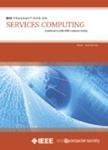版权所有:内蒙古大学图书馆 技术提供:维普资讯• 智图
内蒙古自治区呼和浩特市赛罕区大学西街235号 邮编: 010021

作者机构:Renmin Univ China Sch Informat Minist Educ Beijing 100872 Peoples R China Renmin Univ China Key Lab Data Engn & Knowledge Engn Minist Educ Beijing 100872 Peoples R China
出 版 物:《IEEE TRANSACTIONS ON SERVICES COMPUTING》 (IEEE Trans. Serv. Comput.)
年 卷 期:2024年第17卷第1期
页 面:263-276页
核心收录:
学科分类:0808[工学-电气工程] 08[工学] 0835[工学-软件工程] 0812[工学-计算机科学与技术(可授工学、理学学位)]
基 金:National Key Research and Development Program of China
主 题:Monitoring Blockchains Quality of service Edge computing Probabilistic logic Measurement Clustering algorithms QoS monitoring edge computing blockchain probabilistic threshold query
摘 要:In edge computing, applications are usually delivered as services, each of which runs independently and cooperates to construct complicated applications. QoS (Quality of Service) monitoring is an important way to detect and locate faulty services. In a decentralized environment, QoS monitoring will face trust problem because it is difficult to guarantee the trustworthiness of monitoring results. This article builds a blockchain system for QoS monitoring. However, there are two challenges. First, although the blockchain consensus ensures the consistency of on-chain data among nodes, there is no guarantee that the monitoring data collected in the decentralized environment are authentic, because malicious nodes may report falsified data. Second, in order to handle service faults in time, the real-time query is usually required for obtaining monitoring data. But, blockchains suffer from inefficient querying, because the sequential data storage of blockchain is designed for write intensive applications at the expense of some read performance. To address these challenges, this article proposes a clustering-based algorithm for validating the authenticity of monitoring data collected in the decentralized environment, and proposes a probabilistic threshold query over blockchain, which supports efficient querying and guarantees the probability that the query results are correct is not less than a given threshold. This article implements the proposed blockchain system based on the blockchain platform Hyperledger Fabric and the edge computing platform KubeEdge. The experiment results demonstrate the proposed blockchain system provides high-throughput and low-latency monitoring ability, and can efficiently obtain monitoring results close to real QoS data.